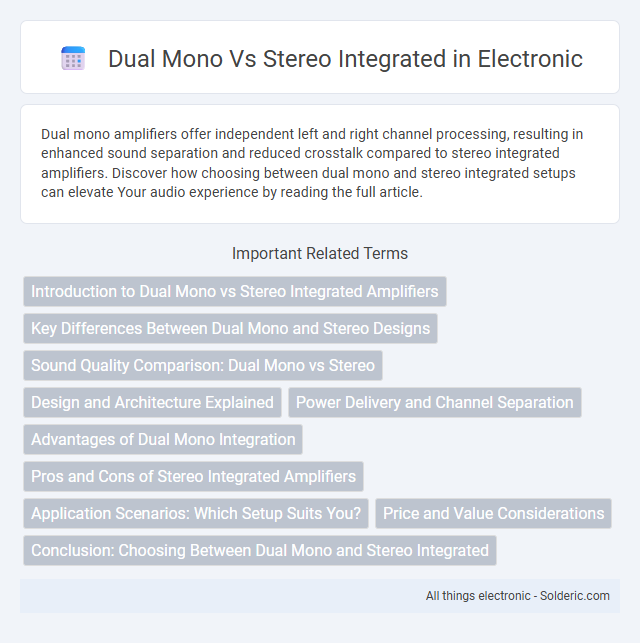Dual mono amplifiers offer independent left and right channel processing, resulting in enhanced sound separation and reduced crosstalk compared to stereo integrated amplifiers. Discover how choosing between dual mono and stereo integrated setups can elevate Your audio experience by reading the full article.
Comparison Table
| Feature | Dual Mono Integrated Amplifier | Stereo Integrated Amplifier |
|---|---|---|
| Channel Configuration | Independent, fully separated left and right channels | Shared circuitry for left and right channels |
| Sound Quality | Improved channel separation, higher fidelity, reduced crosstalk | Good sound quality, but potential channel interference |
| Power Output | More powerful, balanced output per channel | Moderate power, less balance between channels |
| Size & Weight | Larger and heavier due to dual amplifiers | Smaller and lighter design |
| Price | Higher cost due to complex design | More affordable for general use |
| Use Case | High-end audiophile systems, professional setups | Casual listening, home audio systems |
Introduction to Dual Mono vs Stereo Integrated Amplifiers
Dual mono integrated amplifiers feature separate amplification channels with independent power supplies and circuitry for the left and right audio signals, reducing crosstalk and enhancing channel separation. Stereo integrated amplifiers combine both channels within a single chassis and shared power supply, offering a more compact design but potentially less isolation between channels. Audiophiles often prefer dual mono designs for improved soundstage precision and clarity, while stereo integrated amplifiers provide convenience and cost efficiency.
Key Differences Between Dual Mono and Stereo Designs
Dual mono integrated amplifiers use two entirely separate amplifier channels with independent power supplies and circuitry, minimizing crosstalk and enhancing channel separation for improved sound clarity. Stereo designs combine both channels within a single chassis and power supply, which can lead to slight interference but typically offers a more compact and cost-effective solution. Your choice depends on whether you prioritize sonic precision and isolation or convenience and budget considerations.
Sound Quality Comparison: Dual Mono vs Stereo
Dual mono integrated amplifiers offer superior sound quality compared to stereo units by providing separate power supplies and signal paths for each channel, reducing crosstalk and channel interference. This separation results in improved channel separation, enhanced stereo imaging, and greater dynamic range, delivering clearer and more precise audio reproduction. Your listening experience benefits from these technical advantages, especially if you seek high-fidelity sound with distinct left and right channel clarity.
Design and Architecture Explained
Dual mono integrated amplifiers feature two completely separate amplifier channels with dedicated power supplies, minimizing crosstalk and enhancing channel isolation for superior sound clarity. In contrast, stereo integrated amplifiers share components and power supplies between channels, which can introduce subtle interference but often save space and cost. Understanding the design differences helps you choose an amplifier that best suits your listening environment and audio fidelity preferences.
Power Delivery and Channel Separation
Dual mono integrated amplifiers provide independent power supplies and amplification circuits for each channel, ensuring higher power delivery and minimizing crosstalk between channels. This design enhances channel separation significantly compared to stereo integrated amplifiers, which share power and circuitry, potentially introducing interference. Improved channel separation in dual mono systems results in clearer sound staging and more accurate imaging for audiophiles.
Advantages of Dual Mono Integration
Dual mono integrated amplifiers offer superior channel separation by providing independent power supplies and circuit paths for each audio channel, reducing crosstalk and distortion for clearer, more precise sound. This design enhances dynamic range and overall audio fidelity, making it ideal for audiophiles seeking the highest quality stereo reproduction. Your listening experience benefits from improved imaging and soundstage depth that stereo integrated amplifiers may struggle to achieve.
Pros and Cons of Stereo Integrated Amplifiers
Stereo integrated amplifiers offer a compact, cost-effective solution that combines preamplifier and power amplifier functions in a single unit, making them ideal for everyday listening and simple setups. Their unified design often results in better synergy between components, but they may face limitations in channel separation and power output compared to dual mono amplifiers, potentially impacting soundstage precision. Your choice depends on whether convenience and space-saving trump the more detailed, isolated channel control afforded by dual mono designs.
Application Scenarios: Which Setup Suits You?
Dual mono integrated amplifiers excel in professional studio environments and audiophile systems where channel separation and reduced crosstalk are critical for accuracy and soundstage clarity. Stereo integrated amplifiers are ideal for casual listening setups, home theaters, and general music enjoyment, offering simplicity and cost-effectiveness without sacrificing balanced sound. Choosing between dual mono and stereo integrated setups depends on specific application requirements such as audio precision, room acoustics, and budget constraints.
Price and Value Considerations
Dual mono integrated amplifiers typically come with a higher price tag due to their separate circuitry for each channel, offering enhanced audio performance and channel separation. Stereo integrated amplifiers generally provide better value for budget-conscious listeners, delivering solid sound quality at a more affordable price point. Evaluating your audio setup and listening preferences helps determine whether the investment in dual mono technology justifies the premium cost.
Conclusion: Choosing Between Dual Mono and Stereo Integrated
Dual mono integrated amplifiers provide separate amplification channels for each stereo side, reducing crosstalk and improving channel separation, which enhances audio clarity and detail. Stereo integrated amplifiers combine both channels into a single chassis, offering convenience and compactness suitable for most listening environments. Your choice depends on whether you prioritize maximum audio fidelity with dual mono or a more straightforward, space-saving setup with stereo integrated models.
Dual mono vs Stereo integrated Infographic

 solderic.com
solderic.com